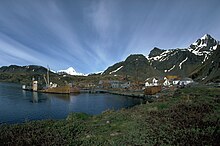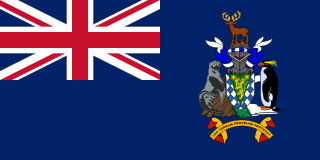
South Georgia and the South Sandwich Islands (SGSSI) is a British Overseas Territory in the southern Atlantic Ocean. It is a remote and inhospitable collection of islands, consisting of South Georgia and a chain of smaller islands known as the South Sandwich Islands. South Georgia is 165 kilometres (103 mi) long and 35 kilometres (22 mi) wide and is by far the largest island in the territory. The South Sandwich Islands lie about 700 kilometres (430 mi) southeast of South Georgia. The territory's total land area is 3,903 km2 (1,507 sq mi). The Falkland Islands are about 1,300 kilometres (810 mi) west from its nearest point.
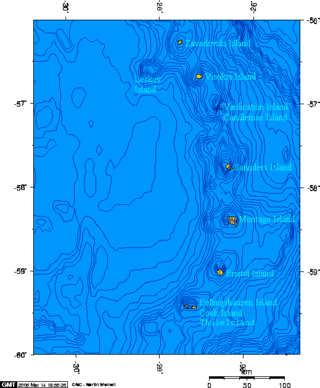
The South Sandwich Islands are a chain of uninhabited volcanic islands in the South Atlantic Ocean. They are administered as part of the British Overseas Territory of South Georgia and the South Sandwich Islands. The chain lies in the sub-Antarctic region, about 700 kilometres (430 mi) southeast of South Georgia and 1,700 kilometres (1,100 mi) northeast from the tip of the Antarctic Peninsula.

Grytviken is a hamlet on South Georgia in the South Atlantic and formerly a whaling station and the largest settlement on the island. It is located at the head of King Edward Cove within the larger Cumberland East Bay, considered the best harbour on the island. The location's name, meaning "pot bay", was coined in 1902 by the Swedish Antarctic Expedition and documented by the surveyor Johan Gunnar Andersson, after the expedition found old English try pots used to render seal oil at the site. Settlement was re-established on 16 November 1904 by Norwegian Antarctic explorer Carl Anton Larsen on the long-used site of former whaling settlements.
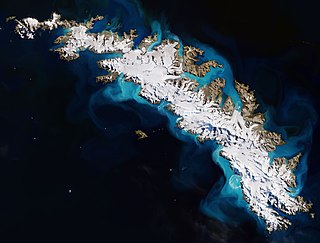
South Georgia is an island in the South Atlantic Ocean that is part of the British Overseas Territory of South Georgia and the South Sandwich Islands. It lies around 1,400 kilometres (870 mi) east of the Falkland Islands. Stretching in the east–west direction, South Georgia is around 170 kilometres (106 mi) long and has a maximum width of 35 kilometres (22 mi). The terrain is mountainous, with the central ridge rising to 2,935 metres (9,629 ft) at Mount Paget. The northern coast is indented with numerous bays and fjords, serving as good harbours.

King Edward Point is a permanent British Antarctic Survey research station on South Georgia island and is the capital of the British Overseas Territory of South Georgia and the South Sandwich Islands. It is situated in Cumberland East Bay on the northeastern coast of the island. The settlement is the smallest capital in the world by population. It is sometimes confusingly referred to as Grytviken, which is the site of the disused whaling station, nearby at the head of King Edward Cove.

Corbeta Uruguay base was an Argentine military outpost established in November 1976 on Thule Island, Southern Thule, in the South Sandwich Islands. It was vacated and mostly demolished in 1982 following Britain's victory against Argentina in the Falklands War.
Sovereignty over the Falkland Islands is disputed by Argentina and the United Kingdom. The British claim to sovereignty dates from 1690, when they made the first recorded landing on the islands, and the United Kingdom has exercised de facto sovereignty over the archipelago almost continuously since 1833. Argentina has long disputed this claim, having been in control of the islands for a few years prior to 1833. The dispute escalated in 1982, when Argentina invaded the islands, precipitating the Falklands War.

The history of South Georgia and the South Sandwich Islands is relatively recent. When European explorers discovered the islands, they were uninhabited, and their hostile climate, mountainous terrain, and remoteness made subsequent settlement difficult. Due to these conditions, human activity in the islands has largely consisted of sealing, whaling, and scientific surveys and research, interrupted by World War II and the Falklands War.
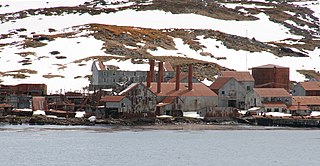
Leith Harbour, also known as Port Leith, was a whaling station on the northeast coast of South Georgia, established and operated by Christian Salvesen Ltd, Edinburgh. The station was in operation from 1909 until 1965. It was the largest of seven whaling stations, situated near the mouth of Stromness Bay.
There were many events leading to the 1982 Falklands War between the United Kingdom and Argentina over possession of the Falkland Islands and South Georgia.

The South Georgia Museum is situated in Grytviken, near the administrative centre of the UK overseas territory of South Georgia and the South Sandwich Islands. Polar explorers Ernest Shackleton and Frank Wild are buried in Grytviken's graveyard. The museum was established in 1991 by Nigel Bonner.

Compañía Argentina de Pesca was initiated by the British-Norwegian whaler and Antarctic explorer Carl A. Larsen, and established on 29 February 1904 by three foreign residents of Buenos Aires: the Norwegian consul P. Christophersen, H.H. Schlieper, and E. Tornquist. Larsen was the company's Manager, in which capacity he organized the building of Grytviken, the first land-based whaling station in Antarctica put into operation on 24 December 1904.
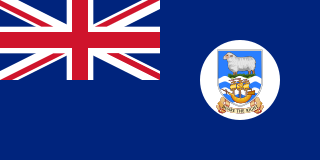
The Falkland Islands Dependencies was the constitutional arrangement from 1843 until 1985 for administering the various British territories in Sub-Antarctica and Antarctica which were governed from the Falkland Islands and its capital Port Stanley.
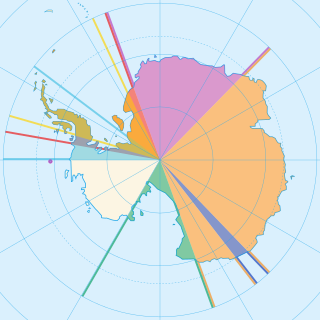
Seven sovereign states – Argentina, Australia, Chile, France, New Zealand, Norway, and the United Kingdom – have made eight territorial claims in Antarctica. These countries have tended to place their Antarctic scientific observation and study facilities within their respective claimed territories; however, a number of such facilities are located outside of the area claimed by their respective countries of operation, and countries without claims such as China, India, Italy, Japan, Pakistan, Russia, South Africa (SANAE), Ukraine, and the United States have constructed research facilities within the areas claimed by other countries. There are overlaps among the territories claimed by Argentina, Chile, and the United Kingdom.
The sole official language of South Georgia and the South Sandwich Islands is English, which is used for nearly all administrative functions in the territory, and is also widely spoken amongst islanders presently.
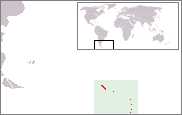
Articles related to the British Overseas Territory of South Georgia and the South Sandwich Islands include:

The invasion of South Georgia, also known as the Battle of Grytviken or Operation Georgias, took place on 3 April 1982, when Argentine Navy forces seized control of the east coast of South Georgia after overpowering a small group of Royal Marines at Grytviken. Though outnumbered, the Royal Marines shot down a helicopter and hit the Argentine corvette ARA Guerrico several times before being forced to surrender. It was one of the first episodes of the Falklands War, immediately succeeding the invasion on the Falkland Islands the day before.
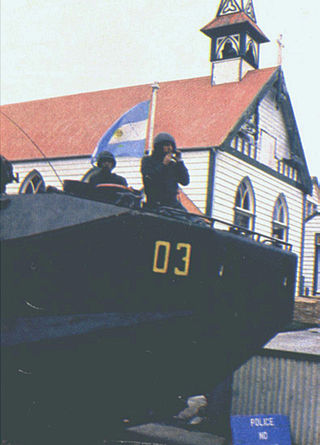
The South Atlantic conflict was a series of crises, undeclared wars, and other conflicts between Argentina, the United Kingdom, and later Chile in the Southern Atlantic Ocean. It was incited by the Argentine navy's prevention of the UK's reoccupation of its territories on the Antarctic Peninsula, and included the Falklands War and Invasion of South Georgia. The conflict, despite a large number of stalemates, ultimately ended in British victory.


